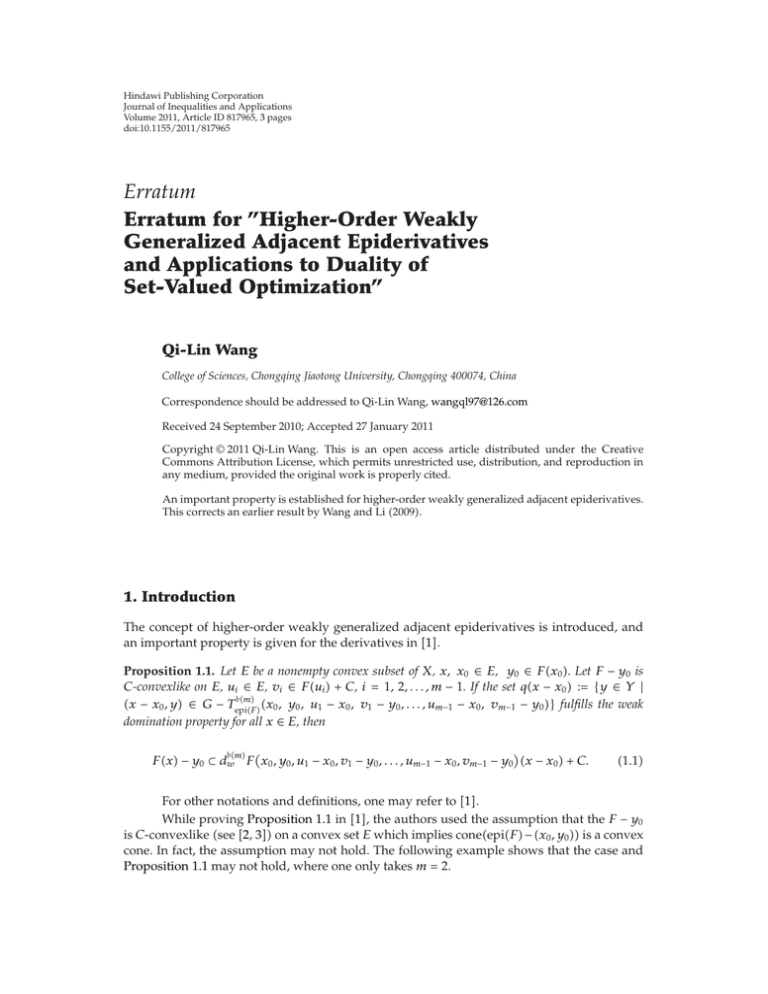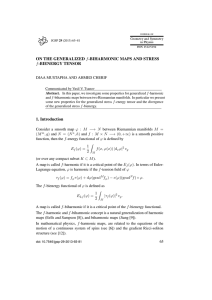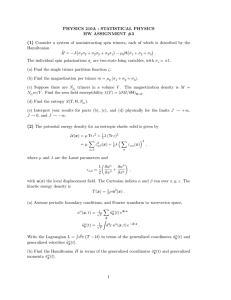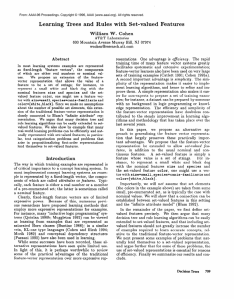Document 10943878
advertisement

Hindawi Publishing Corporation
Journal of Inequalities and Applications
Volume 2011, Article ID 817965, 3 pages
doi:10.1155/2011/817965
Erratum
Erratum for ”Higher-Order Weakly
Generalized Adjacent Epiderivatives
and Applications to Duality of
Set-Valued Optimization”
Qi-Lin Wang
College of Sciences, Chongqing Jiaotong University, Chongqing 400074, China
Correspondence should be addressed to Qi-Lin Wang, wangql97@126.com
Received 24 September 2010; Accepted 27 January 2011
Copyright q 2011 Qi-Lin Wang. This is an open access article distributed under the Creative
Commons Attribution License, which permits unrestricted use, distribution, and reproduction in
any medium, provided the original work is properly cited.
An important property is established for higher-order weakly generalized adjacent epiderivatives.
This corrects an earlier result by Wang and Li 2009.
1. Introduction
The concept of higher-order weakly generalized adjacent epiderivatives is introduced, and
an important property is given for the derivatives in 1.
Proposition 1.1. Let E be a nonempty convex subset of X, x, x0 ∈ E, y0 ∈ Fx0 . Let F − y0 is
C-convexlike on E, ui ∈ E, vi ∈ Fui C, i 1, 2, . . . , m − 1. If the set qx − x0 : {y ∈ Y |
m
x − x0 , y ∈ G − TepiF x0 , y0 , u1 − x0 , v1 − y0 , . . . , um−1 − x0 , vm−1 − y0 } fulfills the weak
domination property for all x ∈ E, then
m Fx − y0 ⊂ dw F x0 , y0 , u1 − x0 , v1 − y0 , . . . , um−1 − x0 , vm−1 − y0 x − x0 C.
1.1
For other notations and definitions, one may refer to 1.
While proving Proposition 1.1 in 1, the authors used the assumption that the F − y0
is C-convexlike see 2, 3 on a convex set E which implies coneepiF − x0 , y0 is a convex
cone. In fact, the assumption may not hold. The following example shows that the case and
Proposition 1.1 may not hold, where one only takes m 2.
2
Journal of Inequalities and Applications
Example 1.2. Let X Y R, C R , E −1, 2 ⊂ R. Consider a set-valued map F : E → 2Y
defined by
Fx ⎧
⎨ y∈Y |y≥0 ,
if x ∈ −1, 2,
⎩{−1},
if x −1.
1.2
Take x0 , y0 0, 0 ∈ graphF, u 1, v 0 ∈ F1 C. Naturally, F − y0 be C-convexlike on
E, but coneepiF − x0 , y0 is not a convex cone.
2
On the other hand, for any x ∈ E, qx − x0 : {y ∈ Y | x − x0 , y ∈ G − TepiF x0 , y0 , u −
x0 , v − y0 } C fulfills the weak domination property. Thus, the assumptions of
Proposition 1.1 are satisfied. But, for x −1 ∈ E,
F−1 − y0 {−1},
m dw F x0 , y0 , u − x0 , v − y0 −1 − x0 C C,
1.3
which shows that the inclusion of 1.1 does not hold here.
2. Properties of Higher-Order Weakly Generalized
Adjacent Epiderivatives
In this section, one presents an important property of higher-order weakly generalized
adjacent epiderivatives which is a correction of 1, Proposition 3.14. Firstly, one gives a
notation of generalized cone-convex set-valued maps.
Definition 2.1. Let F : E → 2Y be a set-valued map, x0 ∈ E, x0 , y0 ∈ graphF. F is said to be
generalized C-convex at x0 , y0 on E, if coneepi F − x0 , y0 is convex.
Remark 2.2. If F is C-convex on convex set E see 4, then, F is generalized C-convex at
x0 , y0 ∈ graphF on E. But the converse may not hold. The following example shows the
case.
Example 2.3. Let E −1, 1 ⊂ R, C R . Consider a set-valued map F : E → 2R defined by
Fx y ∈ R | y ≥ x2/3 ,
∀x ∈ E.
2.1
Take x0 , y0 0, 0 ∈ graphF. Then F is generalized C-convex at x0 , y0 on E, but
F is not C-convex on E.
Journal of Inequalities and Applications
3
Proposition 2.4. Let E be a nonempty convex subset of X, x, x0 ∈ E, y0 ∈ Fx0 . Let F be generalized
C-convex at x0 , y0 on E, ui ∈ E, vi ∈ Fui C, i 1, 2, . . . , m − 1. If the set qx − x0 : {y ∈
m
Y | x − x0 , y ∈ G − TepiF x0 , y0 , u1 − x0 , v1 − y0 , . . . , um−1 − x0 , vm−1 − y0 } fulfills the weak
domination property for all x ∈ E, then, for any x ∈ E, one obtains
m Fx − y0 ⊂ dw F x0 , y0 , u1 − x0 , v1 − y0 , . . . , um−1 − x0 , vm−1 − y0 x − x0 C.
2.2
Proof. The proof follows on the lines of 1, Proposition 3.14 by using generalized C-convex
instead of C-convexlike.
Remark 2.5. In 1, Remark 3.15, one should use “generalized cone-convex” instead of “coneconvexlikeness”. In 1, Theorems 4.5, 4.7, 5.2, one should use “F, G is generalized C × Dconvex at x0 , y0 , z0 on a nonempty subset E” instead of “F, G is C × D-convexlike on a
nonempty convex subset E”.
Acknowledgments
The author would like to thank Professor S. J. Li and the anonymous referees for valuable
comments and suggestions. This paper was partially supported by Science and Technology
Research Project of Chong Qing Municipal Education Commission KJ100419, the National
Natural Science Foundation of China no. 10871216 and no. 11071267, the Natural Science
Foundation Project of CQ CSTC, and the Excellent Young Teachers Program of Chongqing
Jiaotong University, China.
References
1 Q. L. Wang and S. J. Li, “Higher-order weakly generalized adjacent epiderivatives and applications to
duality of set-valued optimization,” Journal of Inequalities and Applications, vol. 2009, Article ID 462637,
18 pages, 2009.
2 Z.-F. Li and G.-Y. Chen, “Lagrangian multipliers, saddle points, and duality in vector optimization of
set-valued maps,” Journal of Mathematical Analysis and Applications, vol. 215, no. 2, pp. 297–316, 1997.
3 G. Y. Chen and W. D. Rong, “Characterizations of the Benson proper efficiency for nonconvex vector
optimization,” Journal of Optimization Theory and Applications, vol. 98, no. 2, pp. 365–384, 1998.
4 H. W. Corley, “Existence and Lagrangian duality for maximizations of set-valued functions,” Journal of
Optimization Theory and Applications, vol. 54, no. 3, pp. 489–501, 1987.







